Abstract
Background:
The global population demands high quality meat and the preference for offal continue to be on the increase. This investigation evaluates consumers’ preference and associated pathological conditions observed in cattle and goat offal in Kumasi, Ghana.
Materials and Methods:
Cross sectional survey and structured questionnaires involving 200 adult respondents were adopted. 105 samples of cattle and goat offal from selected retailers or vendors were also evaluated for associated pathological conditions.
Results:
From the questionnaire, results showed that on the average, one (1) pound of offal was consumed by a household of seven (7) per meal twice a week. The most preferred offal was the fore-stomach (52.70%) followed by the liver (38.10%). However, 75% and 50% of the liver sampled had one or more lesions in the goat and cattle respectively with presence of abscesses, metazoan parasites and granuloma. Factors like availability, affordability, nutritional value, taste, customs and level of education influenced the consumer’s preference for edible offal.
Conclusion:
Presence of metazoan parasites, granuloma and microabbscesses further undermine the quality of the offal supply in Ghana and it calls for further investigation into causal agents of these pathological conditions; hence, strict inspection and assessment should be enforced and maintained for continual provision of edible and wholesome offal.
Keywords: Offal, Preference, Lesions, Ruminants, Ghana
Introduction
Meat is described as any flesh of an animal that is used for food. This includes chevon from goat, beef from cattle and others. The chemical composition and nutritional value of these meats do vary (Soniran and Okunbanjo, 2002). Offal, also called variety or organ meat is a collective term used to describe internal organs or visceral and entrails obtained from a butchered animal or carcass which includes liver, intestines, lungs, heart and kidney. Offal is an essential source of some micro nutrients; it has a higher bioavailability which can hardly be compensated for by plant – derived pro-vitamins (Biesalski, 2005). A daily intake of 100g of liver can supply up to 50% of the recommended daily allowance for iron, zinc, selenium, vitamins B1, B12, B6, B12 and 100% of vitamin A (Biesalski and Nohr, 2009). The increasing demand for higher intrinsic quality meat is traceable to a rise in global population, urbanization as well as increased affluence which has reflected in the rapidly growing livestock industry in local and global meat production, marketing systems and structural adjustments (Speedy, 2003).
Preferential consumption exists in spite of the importance of offal as a source of protein with high biological value. Although the sensory, health related and nutritional properties are the most important product parameters, factors such as economic, social and cultural may be classified as most important motivators for preferring and purchasing a variety meat (Ojewola and Onwuka, 2001).
The preference for offal is a relatively unstable food habit and is increasingly becoming the deciding factor for the development of the livestock sector (Raju and Suryanarayana, 2005). Consumer preference, tastes, visible and invisible characteristics such as marbling and packaging of offal are important factors that determines purchase decisions and price premiums that consumers pay (Langyintuo et al., 2004).
Consumers across diverse cultures in the Kumasi metropolis may have a remarkably similar view of cattle and goat offal eating quality, which could be used to underpin national offal consumption habit and that could also account for the zoonotic diseases often encountered (Phiri, 2006, Frimpong et al., 2011). However, little information is available on meat preference in Ghana.
The issues of meat safety, quality and associated infectious diseases have been long neglected and this aspect often account for the emergence of some zoonotic infectious diseases (Fitzpatrick, 2013). There is significant nutritional, economic and social values placed on the livestock industry in Ghana (MOFA, 2008) with meat and non-meat products being pivotal source of meat-borne diseases, this level of the meat-borne disease is dependent on the conditions under which animals are reared, fed, slaughtered, transported and sold on the Ghanaian markets (Prescott et al., 2002). Fresh raw offal has been implicated in a number of offal-borne infections and intoxications in several countries. This may be associated with the fact that pathogenic and non-pathogenic parasites live in the gastro-intestinal tract, liver, kidney and lung of animals and can be transmitted onto the consumer of such offal under poor processing conditions (Mukhopadhyay et al., 2009). The public health implications of cattle and goat offal transcend all cultural, political and geographical boundaries. The incidence of offal-borne diseases continues to adversely affect the health and productivity of people especially as a source of some zoonotic infectious diseases such as Cysticercosis, Brucellosis, Fascioliasis and Tuberculosis if consumed undercooked (Phiri, 2006). In Ghana, however, there is insufficient information on consumer preference for offal and related public health or zoonotic implications in the offal supply chain. The abattoir system and other slaughterhouses can be valuable sources of information in the offal supply chain concerning the incidence of animal diseases and conditions, which may be zoonotic. This investigation evaluates consumer preference for cattle and goat offal at selected retail hot-points within the Kumasi metropolis and identifies some pathological conditions associated with these offals.
Materials and Methods
Study Area
The study was carried out in the Kumasi metropolis where participants who confirmed preference for cattle and goat offal qualified hence enrolled into the survey.
Study Design
The survey is a cross-sectional study, which seeks to evaluate the preferential consumption and diseases associated with cattle and goat offal retailed in the Kumasi metropolis. Questionnaires were administered to 200 consumers of cattle and goat offal prior to sample collection.
Study Population
200 adult participants who indicated preference for cattle and goat offal and vendors of the offal that live within Kumasi metropolis were the legible respondents of well-structured questionnaires. 105 Cattle and goat offal were sampled from selected retailers or vendors within the Kumasi Sub-metro area for the survey.
Ethical Considerations
Ethical clearance was sought from the Ethical Committee of the Komfo Anokye Teaching Hospital (KATH) through the joint KATH/KNUST Committee on Human Research Publication and Ethics (CHRPE).
Sampling
Questionnaires were administered to all who qualify to participate in this survey. While focus groups, each with between 7 and 9 participants were conducted in Kumasi in May 2014. In total, 65 individuals aged between 19 and 60 years took part in the discussions. All participants were cattle and goats offal eaters and buyers who consumed offal from “at least once a week” to “almost daily”. The focus group discussions were based on a common topic guide, translated into the common language. The guide consisted of several sections, designed to elicit information on respondents’ consumption of cattle and goat offal and their opinions about and attitudes towards cattle and goat offal safety and health.
Macroscopic and Microscopic Examination
Based on data from preferential consumption survey for specific cattle and goat offal, gross postmortem examination of military abscesses or lesions and any globular appearance of study samples were conducted in situ prior to fixation and tissue processing. Representative sections of offal from selected butcher shops and vendors within the metropolis were preserved in 10% neutral buffered formalin, processed routinely for detailed histological examination using Haematoxylin and Eosin stains and light microscopy.
A total of one hundred and five (n= 105) cattle and goat offal samples. 50 cattle offal, 50 goat offal and 5 control samples, specifically liver, stomach, intestine and lungs from various species of local breeds were collected from retailers at selected markets within the metropolis while control samples were obtained from condemned offal at the abattoir based on specific condition for condemnation.
Data Management and Result Analysis
Responses from the questionnaire were tested using descriptive statistics and were presented in percentages. The findings from the focus group discussions were also summarized. The raw data obtained from the histological assessment was analyzed using Statistical Package for Social science (SPSS) 16.0.
Results
Preferential Offal Consumption Level of the Respondents
A total of 200 questionnaires were administered to individual respondents from selected sub-metro areas, representing their households within the Kumasi Metropolis. The standard parameters on the checklist seek to evaluate consumer preference for specific offal such as the liver, kidney, intestine, stomach, heart and tongue.
On the average, one (1) pound (0.45kg) of offal was consumed by a household of seven (7) per meal twice a week. The most preferred offal within the Kumasi Metropolis was the stomach (52.70%) followed by the liver (38.10%).
Educational Impact on Preference
The educational background of respondents was thought to have influence on preferential consumption with respect to customs and purchasing power. The elite had the highest frequency of 95 denoting 48.5% whereas those within the first cycle bracket had the lowest frequency of 36 representing 16.3% (table 1).
Table 1.
Educational background of respondents.
| Educational background | ||
|---|---|---|
| Frequency | Percent | |
| Basic | 36 | 16.3 |
| Secondary | 69 | 35.2 |
| Tertiary | 95 | 48.5 |
| Total | 200 | 100.0 |
Specific Animal and the Consumer
The respondent indicated their choice between cattle and goat which were considered in this survey. Based on data collected, 138 respondents, representing 70.1% preferred both cattle and goat, as 38 representing 19.2% and 21 representing 10.7% indicated their preference for only cattle and only goat respectively (figure 2).
Figure 1.
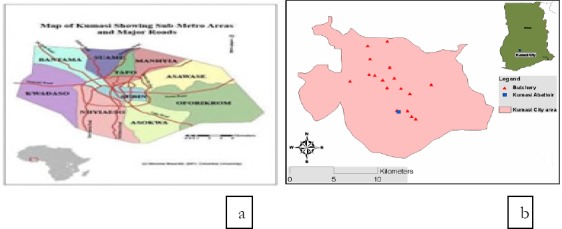
Study area and locations of Kumasi Abattoir. (a)The sub metro areas and major roads; (b) The seventeen recognized butcheries and Kumasi abattoir on the map of Kumasi City.
Figure 2.
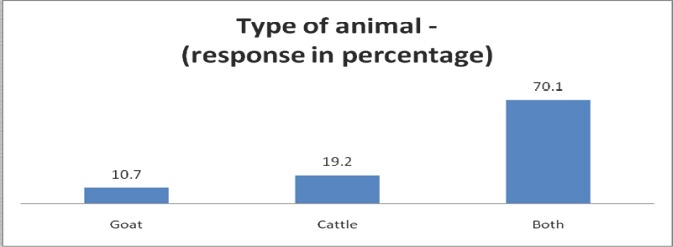
Specific animal preference as indicated by consumer of offal.
The Retail Market for Offal
The main sources of retail offal among others include the Open market, Butcher shops, Super Markets and own raised animals. The respondents purchased their preferred offal mostly from the Butcher shops (56.0%), Open market (42.5%), Own animals (1.0%) and (0.5%) which has a bearing on the survey (figure 3).
Figure 3.
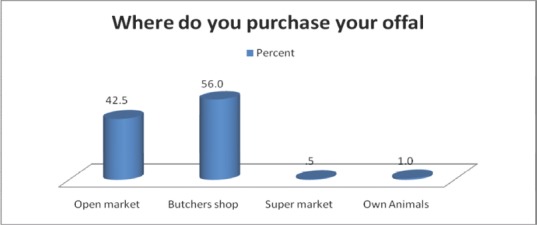
The different sources of offal retail by Kumasi residents
Specific Preferential Consumption of offal
Although consumers of cattle and goat offal are from different walks of life, with diverse backgrounds, preferential consumption of offal exists among them within the Kumasi Metropolis. Majority of respondents in this survey, 98 (52.7%), preferred cattle and goat forestomach, followed by 72 (38.7%) accepted the liver as their most favourite offal. 14 (7.5%) of the respondents and 2 (1.1) preferred the intestine and lungs respectively (figure 4).
Figure 4.
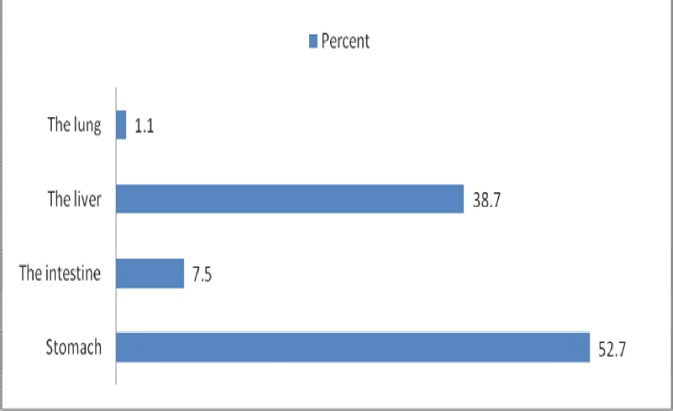
Chart showing Specific offal preference in Kumasi metropolis
Reasons for Preferential Consumption
The reasons assigned by respondent for their preferences were nutritional value, delicacy and cost as illustrated in figure 5.
Figure 5.
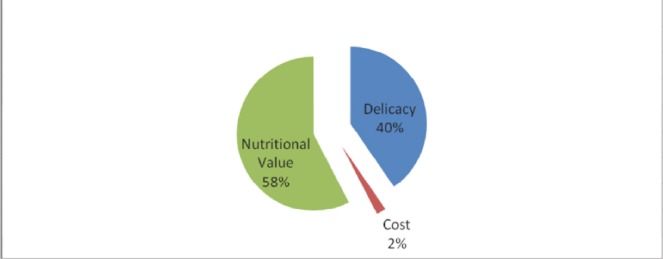
Reasons for offal preference given by Kumasi consumers
Histological Assessment of Preferred Offal
The evaluation of tissues showed patterns of necrosis, cellular infiltrates with formation of microabbscesses (Figure 6B) having abundant purulent infiltrates, disorganization of tissue architecture with fibrinoid necrosis (Figure 6A). The liver was the organ with frequent lesions. 75% and 50% of the liver sampled had one or more lesions in the goat and cattle respectively with presence of metazoan parasites (Figure 6C) and granuloma formation (Figure 6D) especially in the liver. These conditions and their respective percentages in cattle and goat offal are illustrated in table 3. Controls were also evaluated simultaneously.
Figure 6.
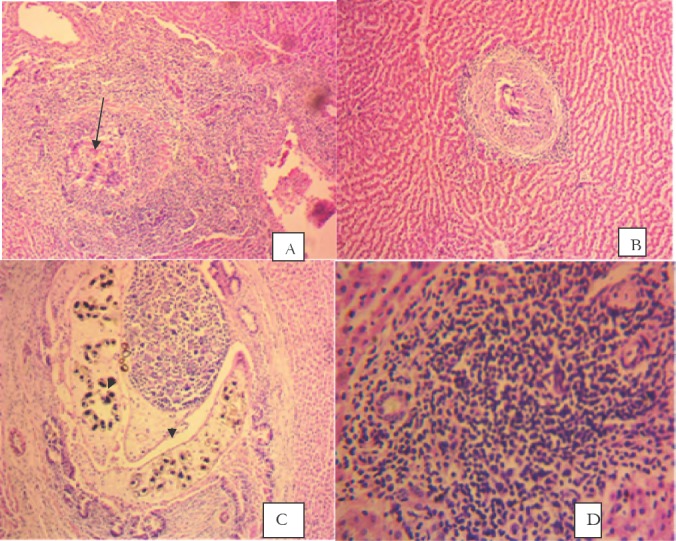
Liver showing: A- microabscess (arrow) in hepatic parenchyma B- vasculitis with fibrinoid degeneration. H & E (x 100). C – parasitic ova (arrow) in portal area. D- granuloma in portal area. H & E (x 100)
Table 3.
Histological assessment of offal from goat and cattle in Kumasi
| Offal/Organ | Sample size | Conditions | No of conditions | Total Pearson | p-value Chi-square value | ||
|---|---|---|---|---|---|---|---|
| Goat | Cattle | ||||||
| Liver | 20 | Necrosis Abscesses Lymphatic infiltration Granuloma with parasites *NAD |
0 4 (20%) 4 (20%) 7 (25%) 5 (25%) |
2 (10%) 3 (15%) 2 (10%) 3 (15%) 10 (20%) |
2 7 6 10 15 |
0.16 0.71 0.41 0.21 0.15 |
2.00 0.14 0.67 1.60 1.67 |
| Stomach | 20 | Abscesses Lymphatic infiltration Granuloma with parasites *NAD |
ND | ND | ND | ND | |
| Intestine | 5 | Abscesses Lymphatic infiltration Granuloma with parasites *NAD |
ND | ND | ND | ND | |
| Lungs | 5 | Abscesses Lymphatic infiltration Granuloma with parasites *NAD |
ND | ND | ND | ND | |
NAD- No Abnormality Detected, ND- Not Detected
p-value test was set at 5% significant level (0.05)
Discussion
This investigation evaluates consumer preference and associated pathological conditions observed in cattle and goat offal in Kumasi. In this study, it was observed that preferences for offal do not always coincide with the actual dietary and food consumption pattern of the respondents. The preferred offal was the fore-stomachs of cattle and goats while the liver was the second. These show that numerous factors which include, availability, affordability, nutritional value, taste, customs and level of education have influence the consumer’s preference for edible offal in Kumasi, Ghana.
This study also showed that cattle and goat offal especially the liver harbour metazoan parasites and this may be associated with the fact that they are run in large flocks or herds, concentrated in confined areas that favour the buildup of these parasites which have been reported to be transmitted to humans in most tropical and third world countries.
The presence of these resistant, resting stage (egg or cyst) in these metazoan parasites observed in some of the livers of goats and cattle examined showed that these parasites may not be killed by light cooking and freezing (Northrop-Clewes et al., 2000) hence the presence in the liver examined significantly affects the safety and quality offal supply (Fitzpatrick., 2013) within Kumasi metropolis.
These findings from this study corroborate the findings of Frimpong et al., 2011 who observed that most butchers in Kumasi sometimes sourced from sick animals and the meat is always transported in unhygienic vehicles. These practices imply a serious public health concern. Other reports from Western Province of Zambia also revealed that common infectious zoonotic conditions such as Cysticercus bovis and Fasciola gigantica, made livers (46.8 %) and lungs (11.0 %) the most condemned offal (Phiri., 2006). The presence of granuloma and microabbscess further undermine the quality of the offal supply in Ghana and it calls for further investigation into causal agents of these pathological conditions although Tuberculosis, Cysticercus bovis and Fasciola gigantica, had been incriminated (Phiri., 2006). In conclusion, strict inspection and assessment should be enforced and maintained for continual provision of edible and wholesome offal.
Acknowledgement
Sincere appreciation to Kumasi abattoir company and Kumasi municipal council and the respondents for their support during the field work.
References
- 1.Biesalski H. K. Meat as a component of a healthy diet - are there any risks or benefits if meat is avoided in the diet? Meat Science. 2005;70:509–524. doi: 10.1016/j.meatsci.2004.07.017. [DOI] [PubMed] [Google Scholar]
- 2.Biesalski H. K, Nohr D. The nutritional quality of meat. In: Kerry J.P, Ledward D, editors. Improving the sensory and nutritional quality of fresh meat. 1st edn. Cambridge: Woodhead Publishing Ltd, England; 2009. [Google Scholar]
- 3.Corner L. A, Melville L, McCubbin K, Small K. J, McCormick B. S, Wood P. R, Rothel J. S. Efficiency of inspection procedures for the detection of tuberculous lesions in cattle. Austr Vet J. 1990;67:389–392. doi: 10.1111/j.1751-0813.1990.tb03020.x. [DOI] [PubMed] [Google Scholar]
- 4.Dorny P, Praet N, Deckers N, Gabriel S. Emerging food-borne parasites. Vet. Parasitolo. 2009;7(3):163. 196–206. doi: 10.1016/j.vetpar.2009.05.026. [DOI] [PubMed] [Google Scholar]
- 5.Fitzpatrick J.L. Global food security. The impact of Veterinary parasites and parasitologists. Veterinary Parasitology. 2013;195:233–248. doi: 10.1016/j.vetpar.2013.04.005. [DOI] [PubMed] [Google Scholar]
- 6.Frimpong S, Gebresenbet G, Bosona T, Bobobee E, Aklaku E, Hamd I. Animal Supply and Logistics Activities of Abattoir Chain in Developing Countries: The Case of Kumasi Abattoir, Ghana. Journal of Service Science and Management. 2012;5:20–27. [Google Scholar]
- 7.Langyintuo A, Ntoukam G, Murdock L, Lowenberg_DeBoer J, Miller D. J. “Consumer Preference for Cowpea in Cameroon and Ghana,”. Agricultural Economics. 2004;30:203–213. [Google Scholar]
- 8.Mukhopadhyay H.K, Pillai R.M, Pal U.K, Ajay V.J. Microbial quality of fresh chevon and beef in retail outlets of Pondicherry Tamilnadu. Journal of Veterinary and Animal Sciences. 2009;5(1):33–36. [Google Scholar]
- 9.Northrop-Clewes C.A, Shaw C. Parasites. British Medical Bulletin. 2000;56(1):193–208. doi: 10.1258/0007142001902897. Retrieved on July 1, 2011. From <bmb. oxfordjournals.org>. [DOI] [PubMed] [Google Scholar]
- 10.Ojewola G. S, Onwuka G. I. Evaluation of the organoleptic properties of “suya” produced from various sources of meat. Nig. J. Anim. Prod. 2001;28(2):199–201. [Google Scholar]
- 11.Phiri A.M. Common conditions leading to cattle carcass and offal condemnation at three abattoirs in western province of Zambia and their zoonotic implication to consumers. J. South Afr. Vet. Assoc. 2006;77:28–32. doi: 10.4102/jsava.v77i1.336. [DOI] [PubMed] [Google Scholar]
- 12.Prescott L. M, Harley J. P, Klein D. A. Microbiology. 5th Edition. Boston, USA: The WCB McGraw-Hill companies; 2002. Food and Industrial Microbiology; pp. 125–964. [Google Scholar]
- 13.Raju D.T, Suryanarayana M.V.A.N. Meat consumption in Prakasam district of Andhra Pradesh: an analysis. Livestock Research for Rural Development. 2005;17:1–8. [Google Scholar]
- 14.Speedy A.W. Global Production and Consumption of Animal Source Foods. JNutr. 2003;133:4048S–4053. doi: 10.1093/jn/133.11.4048S. [DOI] [PubMed] [Google Scholar]
- 15.Soniran O.G, Okubanjo A.O. Physico- chemical and sensory characteristics of pork loin roast cooked to three internal temperatures. Nig. J. Anim. Prod. 2002;29(1):138–141. [Google Scholar]


